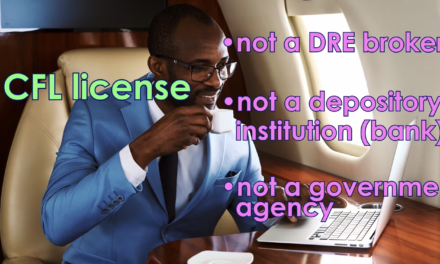This article discusses the use of the Natural Hazard Disclosure Statement.
A unified disclosure for all sales
In transactions involving the sale of any type of real estate, the seller’s listing broker owes a duty to a prospective buyer to disclose, along with any other facts that have a significant impact on a property’s value and desirability:
- the broker’s actual knowledge of any natural hazards affecting the value of the property; and
- information contained in public records concerning natural hazards. [Calif. Civil Code §1103(c)]
If the seller has not listed the property with a broker, the seller must disclose any natural hazards known to him or contained in public records. The seller must disclose his knowledge of the natural hazards of his property’s location by use of a statutorily mandated form.
Natural hazards come with the location of a parcel of real estate, not with its physical, environmental, title or use conditions. Natural hazards include:
- special flood hazard areas – a federal designation;
- potential flooding and inundation areas;
- very high fire hazard severity zones;
- wildland fire areas;
- earthquake fault zones; and
- seismic hazard zones.
The existence of a hazard at the location of a property affects its value and desirability to prospective buyers since the hazard limits the buyer’s ability to develop, obtain insurance or receive disaster relief.
In 1998, the California legislature created a form entitled the Natural Hazard Disclosure Statement. The Natural Hazard Disclosure Statement is to be used in the preparation and disclosure of natural hazard information known to sellers and listing brokers and located in public records. [CC §1103.2]
Use of the Natural Hazard Disclosure Statement was then mandated on the sale of one-to-four unit residential property. Some sellers are excluded – but not brokers.
Regarding excluded sales and sales on other than one-to-four unit residential property, use of the Natural Hazard Disclosure Statement is optional for the seller’s and broker’s delivery of natural hazard information to buyers. [CC §1103.1(b)]
However, all sellers, and any listing and selling brokers involved, have an initial common law duty on the sale of any property, whether or not the use of a Natural Hazard Disclosure Statement is required, to disclose conditions on or about the property which are known to them and might affect the buyer’s willingness to buy or set the price to be paid. Natural hazards, or the lack thereof, irrefutably affect a property’s value and desirability and thus must be disclosed. [Karoutas v. HomeFed Bank (1991) 232 CA3d 767]
If the property being sold is not a one-to-four unit residential property, or is a one-to-four unit residential property excluded from actual use of the Natural Hazard Disclosure Statement, the seller and the broker must still deliver natural hazard information known to them under their common law duty to the buyer. [CC §1103.1(b)]
Thus, on sales of one-to-four unit residential property other than those excluded, the sale must include delivery of the Natural Hazard Disclosure Statement on the mandated form, containing both the seller’s and the listing broker’s actual knowledge of hazards, along with any hazards disclosed by public records. [CC §§1103.2(a); 1103.12(a)]
Investigating the existence of a hazard
The duty to investigate the public records for natural hazard information is not imposed on anyone – not the seller, not the brokers (be they the seller’s or the buyer’s broker), not a geologist, and not a natural hazard expert. No one is mandated or obligated to investigate, nor does an implication exist that any particular person is to do so. Yet, the Natural Hazard Disclosure Statement must be delivered to the buyer.
Thus, the natural hazard disclosure information must be obtained by someone. To obtain it, the seller and his broker are required to exercise ordinary care. [CC §1103.4(a)]
The natural hazard information may be obtained by the seller or his broker:
- directly from the public records; or
- on request from a natural hazard expert, such as a geologist. [CC §1103.4(a),(c)]
Thus, the seller’s broker need never check the public records himself. The broker need only:
- request a Natural Hazard Disclosure from a reliable expert in natural hazards, such as a geologist who has studied the public records (as some natural hazards clearly do not pertain to geology); and
- review the Natural Hazard Disclosure prepared by the expert to add any actual knowledge the broker may possess, contrary or supplemental, in an addendum attached to the expert’s Natural Hazard Disclosure.
Once the Natural Hazard Disclosure is in the hands of the seller’s broker, the broker makes it available to prospective buyers and their brokers as part of the listing package used to market the property. [CC §1103.4(b),(c)]
Delivery of the Natural Hazard Disclosure to the buyer
The buyer’s broker has the duty to hand to the buyer the Natural Hazard Disclosure Statement obtained from the seller or the seller’s broker, called delivery. [CC §1103.12(a)] If the buyer does not have a broker, the seller’s broker must deliver the Natural Hazard Disclosure Statement to the buyer. | The Natural Hazard Disclosure should be delivered on the day or before the buyer makes an offer. |
The Natural Hazard Disclosure is not part of the contractual (purchase) agreement between the seller and the buyer, but is merely a disclosure of the natural hazards which impact the property as known to the seller and the seller’s broker and reported in public records. [CC §1103.2(a)]
When disclosures concerning the value and desirability of a property are to be delivered to the buyer, such as a Natural Hazard Disclosure, the buyer should receive such price-sensitive information before making an offer.
Delivery of the Natural Hazard Disclosure Statement before an offer is made is implicit in the natural hazard scheme. When the broker hands over the Natural Hazard Disclosure after the offer has been accepted, the buyer is by statute given the remedy of cancelling the purchase agreement within three days after his receipt of the belated and unacceptable Natural Hazard Disclosure. [CC §1103.3(c)]
Good brokerage practice is the delivery of the Natural Hazard Disclosure on the day or before the buyer makes an offer. Further, the offer would include a copy of the Natural Hazard Disclosure as an addendum. Thus, the seller and the brokers would not have to contend with the buyer’s three-day right to cancel – the delivery of the Natural Hazard Disclosure would precede submission of the offer.
Actually, the competent listing broker gets the seller to authorize and pay for the Natural Hazard Disclosure from the natural hazard expert at the time he takes the listing, so the property can be marketed “as disclosed” in a pre-purchase listing package. No surprises for anyone, and a much less time-consuming closing (for which some brokers charge a reduced fee).
The first practical time for the seller’s broker to obtain the natural hazard information is when the listing is taken. Thus, the Natural Hazard Disclosure will be available before the property is marketed. The Natural Hazard Disclosure can then be handed to a buyer or his broker before making an offer. [CC §1103.3(a)]
Excluded sellers, not brokers
While all sellers of properties must disclose what is known to them about the natural hazards endemic to a property’s location, the following transactions are excluded from use of the mandated Natural Hazard Disclosure Statement form:
- court-ordered transfers or sales;
- deed-in-lieu of foreclosure;
- trustee’s sales;
- lender resale after foreclosure or deed-in-lieu;
- estates on death;
- transfers between co-owners;
- transfers to relatives/spouse; or
- transfers to or by governmental entities. [CC §1103.1(a)]
However, any broker involved in any of these excluded transactions must himself make the hazard disclosures. [CC §1103.1(b)]
Since all sellers, excluded or included, must disclose what they know about the hazards, and the brokers on the sale must deliver information from the public record on hazards in addition to disclosing their actual knowledge, the Natural Hazard Disclosure Statement should be used on all sales. On excluded properties, the broker should order a report from the natural hazard expert, review it to add what he knows, and hand it to the buyer on or before the offer is made. Thus, surprises (litigation) are avoided – before or after closing.
Broker liability avoided
The Natural Hazard Disclosure scheme encourages brokers to use natural hazard experts by relieving the brokers (and sellers) of liability if an expert reports on the contents of the public record.
An indemnity agreement with a natural hazards expert will cover court costs if the broker is sued. | Neither the seller nor any broker, be he the seller’s or the buyer’s, is liable for the erroneous preparation of a Natural Hazard Disclosure Statement which is delivered to the buyer if:
|
Neither the seller nor the brokers need to be indemnified by the natural hazard expert to avoid liability for errors. By statute, the expert who prepared the Natural Hazard Disclosure is liable, not the seller or brokers. However, if the brokers are sued based on the inaccuracy of the expert’s report, an indemnity agreement entered into by the expert, in exchange for the broker’s request to prepare a natural hazard report, will cover the costs of litigation which unnecessarily hauled the broker into court.
However, a belated delivery of an expert’s Natural Hazard Disclosure to the buyer after the offer has been accepted will not protect the broker who knew or should have known of a natural hazard and failed to disclose it to the buyer before the buyer entered into a purchase agreement with the seller. Liability exposure includes costs incurred to correct or remedy the previously undisclosed hazardous condition, or the portion of the price which exceeds the property’s fair market value based on the undisclosed hazard. [Jue v. Smiser (1994) 23 CA4th 312]
Further, the brokers, the seller and the expert are not exposed to liability from third parties to the sales transaction who might receive the Natural Hazard Disclosure and rely on it to analyze the risk of their involvement. Such third parties include insurance companies, lenders, government agencies, etc. [CC §1103.2(f)]
Redundant disclosure exposure
Some brokers insist on multiple disclosures of the same information, a redundancy and possibly an act of paranoia. Worse, the duplicate disclosures might not be a redundancy at all, but a repetitive disclosure already referenced in another disclosure scheme with its own liability.
If the duplication is a redundancy, such as an addendum relating to earthquakes, it is a waste of time and confusing. If the hazard is intended to be disclosed under an all-inclusive disclosure scheme, the broker’s liability exemption under the natural hazard scheme by using an expert will not apply to the duplicate disclosure. [CC §1103.1(b)]
Thus, preparing the Natural Hazard Disclosure Statement (which supersedes other natural hazard disclosure sections) and disclosing a particular hazard again in a separate document (seismic fault, flood, etc.) creates a hazard the broker does not need.













